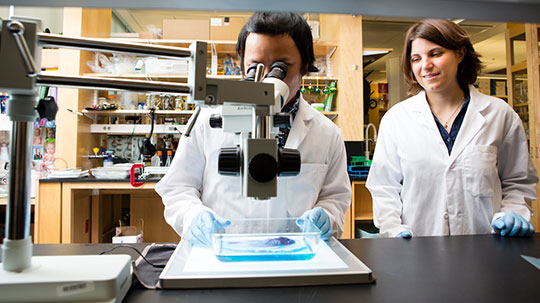Spring: n/a
Summer: n/a
Overview
The PhD in Biology is a research-intensive program and also has a strong focus on teaching. The program's primary goal is to develop independent and creative research scientists, which is accomplished through research training, graduate-level courses, seminars, and teaching experience. Your advisory committee of three faculty members will work with you to plan a program of study based on your experience, interests and goals.
Because our program is very individualized, we encourage interested students to look over faculty research areas and email a potential supervisor for information before the application deadline. An effective email is a brief summary of your background and interests and how they fit with the research in a specific lab group. All admissions decisions are made by the Biology Department Graduate Admissions Committee, only after receipt of a full application through this website.
Program Outcomes
As a student in the program, you'll receive extensive training in pedagogy, outreach, and communication that will prepare you for careers in academia, biotechnology, education, and policy. Graduate students serve as teaching assistants in undergraduate courses and have the opportunity to take a course on teaching and pedagogy to improve their skills, or to become involved with upper-level courses in their area of expertise. During the first year, you'll also become familiar with research opportunities in the department by doing short research rotations with various faculty members. This experience in expected to lead to the selection of a research focus for your PhD thesis, and it also sets the stage for cross-disciplinary approaches to the thesis topic.
Graduates of the PhD in Biology become top research scientists and educators equipped with a broad base of knowledge to tackle the most important biological problems of today.

Application Requirements
- Application fee
- Resume/CV
- Personal statement
- Official TOEFL, IELTS, or Duolingo English Test, if applicable
- Transcripts
- Three letters of recommendation
Tuition and Financial Aid
See Tuition and Financial Aid information for GSAS Programs. Accepted PhD students in Biology receive full tuition support for six years, a competitive stipend, and health coverage.
Concentrations
The graduate program in biology is arranged into six concentrations, each with an advisor and a core of faculty researchers:
Career Outcomes
Average Salary: $90K - $150K+
Would Recommend the Program: 100%*
Average Age: 28
*Sources: GSAS-SOE Graduate Exit Survey 2020 - 2021 and Academic Analytics (Alumni Insights)
Faculty

Eric Tytell

Eric Tytell
Research/Areas of Interest: Biomechanics and Neural Control of Locomotion

Douglas Blackiston

Douglas Blackiston
Research/Areas of Interest: Developmental Biology Animal Behavior Engineered Living Systems Biorobotics The overarching goal of my research program is to understand how developmental events coordinate organism-level behaviors, and how these interactions can inform both biomedical and ecological contexts. To this end, my group studies many aspects of developmental biology to learn about the molecular, genetic, and environmental signaling mechanisms driving behavioral phenotypes/disease, and then use these mechanisms to exert control over form and function, sensory-motor integration, and regenerative outcomes.

Frank David

Frank David
Research/Areas of Interest: Biopharma strategy, regulation, & policy

Erik Dopman

Erik Dopman
Research/Areas of Interest: Evolution and Genetics of Natural Populations

George Ellmore

George Ellmore
Research/Areas of Interest: Ecology, Behavior and Evolution and Global Change Biology

Catherine Freudenreich

Catherine Freudenreich
Research/Areas of Interest: Genetics and Molecular Biology. Genome instability, particularly at sites of repetitive and structure-forming DNA.

Jaye Gardiner

Jaye Gardiner
Research/Areas of Interest: Our scientific curiosity revolves around understanding how viruses can rewire cells to change what genes are expressed and how this altered gene expression changes cellular behavior and interactions with the extracellular matrix (ECM). As obligate intracellular parasites, viruses are adept at hijacking biological processes for their own replication. However, the impact of these co-opted processes on the surrounding uninfected cells and ECM, or the "viral microenvironment", and the long-term sequelae are largely unexplored. Our goal is to study these questions within the context of fibrotic diseases, such as idiopathic pulmonary fibrosis, pancreatitis, and liver fibrosis as viral infections are frequently a cause of fibrosis and most chronic fibroses remain unresolved and result in organ failure or cancer development. Our research can be described in the following three major themes; where projects in one theme will learn from and build on our knowledge from the others. .Theme 1: Chromatin/transcriptional regulation of fibroblastic cells Projects in this theme will work to investigate the interplay between ECM signaling, chromatin remodeling, and transcriptional gene activation. In particular, we aim to answer the questions: - How do fibroblasts maintain a chronic activation status in fibrotic diseases despite lacking in vivo. cues? - How does the chromatin of fibroblastic cells change over the course of fibrotic disease development? - How are the above questions affected by different ECM components? Theme 2: Viral manipulation of the extracellular matrix Projects in this theme work to answer the questions: - How do virally infected cells alter the local environment they are in? - How do changes in the microenvironment resolve or persist after a viral infection is cleared? - Are changes in the viral microenvironment the same as other initiators of fibrotic diseases?. Theme 3: Non-oncogenic viruses and cancer Projects in this theme work to answer the questions: - How do non-oncogenic viral infections affect cancer formation and metastasis? - How do anti-viral treatments alter the microenvironment? - What is the impact of oncolytic viruses on the surrounding microenvironment?

Sarah Hengel

Sarah Hengel
Research/Areas of Interest: Our research is interested in understanding how environmental toxicants human beings experience in our environment change our DNA. We are also interested in how the damaged DNA is repaired by proteins in our nucleus. We are also interested and focused on the intersection of female reproductive diseases (endometriosis, primary ovarian insufficiency, and polycystic ovary syndrome) and female cancers (cervical, endometrial, uterine, and ovarian cancer).

Alfredo Hernandez

Alfredo Hernandez
Research/Areas of Interest: Enzymology of DNA replication, mitochondrial DNA, nucleic acid biochemistry, and non-canonical DNA structures.

Fatima Hussain

Fatima Hussain
Research/Areas of Interest: Vaginal Microbiome Microbial Ecology and Evolution Phage-Bacteria Interactions Bacterial Immunity

Mimi Kao

Mimi Kao
Research/Areas of Interest: Neural basis of vocal communication

Michael Levin

Michael Levin
Research/Areas of Interest: Morphological and behavioral information processing in living systems

Kelly McLaughlin

Kelly McLaughlin
Research/Areas of Interest: Molecular Development (Organogenesis: Development, Remodeling, Regeneration)

Mitch McVey

Mitch McVey
Research/Areas of Interest: DNA repair, DNA damage tolerance, molecular biology, Drosophila genetics, aging, mutagenesis

Sergei Mirkin

Sergei Mirkin
Research/Areas of Interest: Genetics and Molecular Biology

Colin Orians

Colin Orians
Research/Areas of Interest: Agroecology, climate change, climate adaptation, plant-herbivore interactions

Michael Reed

Michael Reed
Research/Areas of Interest: Avian ecology and conservation biology

Michael Romero

Michael Romero
Research/Areas of Interest: Stress Physiology and Field Endocrinology

Randi Rotjan

Randi Rotjan
Research/Areas of Interest: Research in the Rotjan lab focuses on marine ecology and global change. The main goal is to examine how marine species, communities, and ecosystems respond to the complex multitude of stressors emerging in the contemporary world ocean, and how they will respond to the future ocean change that we expect in the coming decades. In other words, we take a multi-level and systems ecology approach to examining global change. We are also big fans of ocean exploration, which is critical and necessary to set and calibrate ecological baselines. We are a part of a growing global movement to democratize the oceans, making marine science and exploration accessible and available to all. We apply our science and exploration to conservation. Our simple credo is to help make the world a better place. Our lab is interested in two complementary dimensions of contemporary marine ecology: (1) ecological response to changing ocean dynamics, and (2) opportunities for human-mediated action via conservation, restoration, and/or management. To learn more, check out our lab website and click through our research pages, publications, news, members, etc.

Philip Starks

Philip Starks
Research/Areas of Interest: Animal Behavior: Recognition systems, evolution of sociality, parasite and host relationships, behavioral & chemical communication, invasion genetics

Julia Svoboda

Julia Svoboda

Khoa Tran

Khoa Tran
Research/Areas of Interest: Epigenetics, Aging, Cellular senescence, and Protein Regulation The Tran lab focuses on epigenetic regulation during cellular senescence and aging. To better understand epigenetics, imagine your DNA as a letters and epigenetics as punctuation in a sentence. As an example, we can use the following sentence: "I'm very hungry. Let's eat, grandma." Without changing any letters in the sentence (DNA) but the punctuation (epigenetics), we can dramatically change the interpretation of the sentence. "I'm very hungry! Let's eat grandma!" My overall research focuses on understanding how these punctuation changes, what mediates these changes, and how they contribute to aging and age-related disorders. Current research projects: • Elucidate the intersection between metabolism and epigenetics in cellular senescence and aging. • Understand how transcriptional regulators are spatially dysregulated during aging • Characterize the epigenetic changes during aging and age-related disorders. Please see my lab website for more information on research projects.

Barry Trimmer

Barry Trimmer
Research/Areas of Interest: Currently we are pursuing the following major projects: Current Projects 1) Modulation of Nociception. — The ability to sense and respond to harmful events (nociception) is ubiquitous in the animal kingdom and in many animals results in a longer lasting sensation called pain. Nociception is a distinct sensory modality that promotes the avoidance of damaging interactions using molecular mechanisms that are well-conserved from single cell organisms to humans. Nociception typically elicits strong responses, such as aggressive or avoidance movements, but these must be chosen appropriately and enhanced (hyperalgesia) or suppressed (hypoalgesia), depending on the circumstances. Our laboratory uses an insect, the tobacco hornworm Manduca sexta, as a model system to study the neurobiology of nociception and its modulation. 2) Neuromechanics of Locomotion — Animal locomotion is an intricate interplay between neural processes and biomechanics. These components have co-evolved to form "neuromechanical" control systems in which neural commands organize actions and the structures and materials of the body translate these commands into movements. In some cases structures are able to accomplish movements with relatively little or no command input, but most behaviors in natural environments require intricate neural patterning. In animals that have stiff skeletons (such as vertebrates and adult stage arthropods), these motor programs rely on the constraints imposed by joints to reduce the degrees of freedom and simplify control. In contrast to animals with skeletons, soft animals do not have the same limits on movements; they can deform in complex ways and have virtually unlimited degrees of freedom. One of our major research goals is to identify how soft animals control their movements in a computationally efficient manner using the principles of embodiment and morphological computation. 3) SoftWorm Robots — a soft machine development platform — Based on extensive neuromechanical studies of soft bodied locomotion in animals, we have developed a family of actuated modules that are being used as development platforms for soft robots. These robots are about 10-15 cm long and weigh between 4g and 30g. Earlier designs were fabricated by vacuum casting silicone elastomers into 3D-printed molds, our current methods include printing the devices in a soft rubbery polymer using a multi-material 3D printer. These devices are actuated with shape-memory alloy (SMA) microcoils that can be controlled with current pulses. We have also constructed similar robots with back-drivable Maxon motors coupled to the body using flexible "tendons". The body shapes can be changed to any desired form, but most of our current prototypes resemble caterpillars or worms. They can crawl, inch or roll and even climb steep inclines. 4) Tissue Engineering of Novel Devices — One of our long-term goals is to "grow" robotic devices using a combination of biosynthetic materials, cellular modulation, and tissue engineering. In collaboration with Professors Kaplan and Levin we are exploring both invertebrate and vertebrate cell culture and regeneration systems to structure muscles and supporting tissues on scaffolds of biomaterials. These scaffolds could be degradable or allowed to remain as part of an operational biorobot. Such biological devices will be controlled using the simulation tools developed for synthetic soft robots and will exploit recent advances in soft material electronics. For these cell-based systems, we are generating bundles of contractile skeletal muscle tissue using insect muscle cells. These constructs will be engineered to contract in a controlled, coordinated fashion for eventual use as motors in soft robots. Insect cells offer novel features, such as high force, low oxygen demand, and low sterility requirements that are particularly advantageous. This work is also being applied in the field of Cellular Agriculture to develop sustainable ethical food production.

Lawrence Uricchio

Lawrence Uricchio
Research/Areas of Interest: Population genetics, evolution, ecology, computational biology

Benjamin Wolfe

Benjamin Wolfe
Research/Areas of Interest: Ecology and evolution of microbial communities